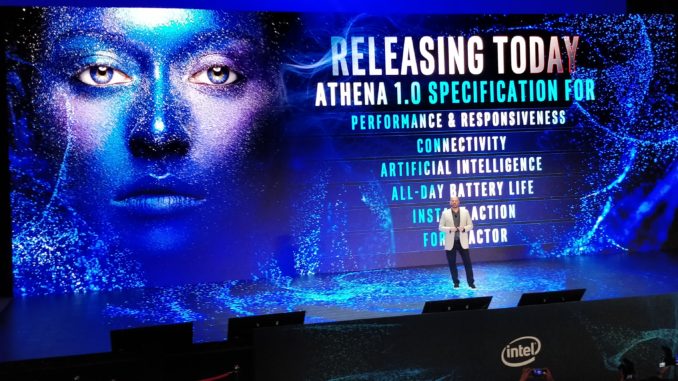
As with Ultrabooks, Intel has introduced a new standard with Project Athena. Notebooks must have an Ice Lake CPU and meet requirements.
Project Athena: Intel’s Best Notebook Experience
In addition to the Ice Lake processors, Project Athena was the main focus at Intel’s Computex 2019 events. This refers to a new standard that the company wants to establish, as it did then, the Ultrabook standard. Most of the big manufacturers like Dell, HP, Acer, Lenovo or Asus participate with their own models. The goal of Project Athena is a notebook that is designed for mobile, efficient and speedy work.
Of course, there are a number of prerequisites for this. The first requirement is the use of a Core i5 or i7 of the new Ice Lake generation. Other hardware requirements are at least 8 gigabytes of memory and 256 gigabytes of NVMe SSD memory. There are also conditions for the connections. Thunderbolt 3 and the new WiFi 6 are standard features of a Project Athena notebook. Both techniques are already directly integrated in Ice Lake. Gigabit LTE should also be possible via an option. The integrated Iris Plus graphics are to be used primarily for the graphics, but dedicated chips are also possible. The form factor also plays a role. Desired are 2 in 1 notebooks with touch display, the size should be between 12 and 15 inches and support pen input. The keyboard must have a backlight, a precise touchpad is also required.
9 and 16 hours battery life, wakes up under one second
There are also numerous prerequisites for modern usability. Users should be able to take the notebook to a normal day without having to carry a power supply. For this, a battery life of 9 hours for web browsing and 16 hours for offline playback is required. Testing must be performed under real-life conditions, i.e. with all background processes. When charging, 30 minutes at the power outlet must suffice for four hours of battery life. There are also conditions for standby. Project Athena notebooks need to wake up in under a second to be up and running again quickly. Either opening the laptop, pressing a button or authenticating with a fingerprint is defined. Speaking of authentication: Project Athena also prescribes possible authentication via biometrics, i.e. via fingerprint or biometric facial recognition.
The Project Athena standard is thus much more complex than the Ultrabook initiative at that time. On the one hand, Intel supports the manufacturers with Open Athena Labs, where the manufacturers are able to let test their hardware from Intel to the requirements. There will also be help from Intel with marketing. The first Project Athena notebooks have already been presented at Computex 2019. These are the Acer Swift 5, the Dell XPS 13 2 in 1, the HP Envy 13 Wood Series, the Lenovo Yoga S940. Further models will follow. The first devices are expected to be available by Christmas 2019.
Notice:
Intel paid our travel expenses for Computex 2019, but has no influence on our reporting.

Be the first to comment